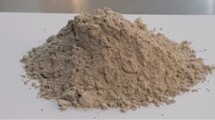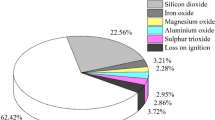Abstract
Foundry sand is used spent in sand molds of ferrous and non-ferrous industries. When it is no longer used, it has become solid wastes generated by foundries. According to European Union regulations, it is a non-hazardous waste so it can be recycled in other industries, especially in cement industry. In the present paper, the mechanical properties and characterization of cement mortars are prepared by using waste foundry sand coming from Turkey steel manufacturer as partial replacement of natural sand were experimentally investigated and the possibility of using waste foundry sand (WFS) instead of natural sand in mortar has been determined. Recycling of solid foundry waste is considered as an environmentally friendly alternative to solve the problem of disposing of the solid wastes. Cement mortar admixtures were prepared by using with variable percentages of WFS ranging from 15 to 60%. Additionally, to make comparison, one reference admixture sample was fabricated without using any waste foundry sand. The effect of WFS on the compressive strength of the cement mortar was analyzed. The compressive strengths values of all the specimens were recorded for 3, 7, and 28 days and results showed that when the amount of WFS replacement is increased, the strength decreased slightly according to the comparison of the reference sample. However, cement mortar containing 15% additive has showed the highest strength value at 3 and 28 days. As a result in the present study, it is observed that optimum additive amount of WFS as replacement of natural sand in cement mortar is 15%. SEM images were also taken to evaluate the relationship between microstructure and strength of the specimens. Moreover, scanning electron microscope (SEM) examination was carried out to explain the effectiveness of the matrix in the reuse of WFS. Microstructural observation of the samples by SEM showed that the sand particles of the WFS were well embedded in the cementitious matrix.






Similar content being viewed by others
References
Joshi, R.: Effect of using selected industrial waste on compressive and flexural strength of concrete. International Joournal of Civil and Structural Engineering. 4(2), 116–124 (2013)
Lamas, W.Q., Palau, J.R.C., Camargo, J.R.: Waste materials co-processing in cement industry: ecological efficiency of waste reuse. Renew Sust Energ Rev. 19, 200–207 (2013)
Chowdhury, S., Roya, S., Maniara, A.T., Suganya, O.: Comparison of mechanical properties of mortar containing industrial byproduct. APCBEE Procedia. 9, 317–322 (2014)
Başar H.M, Aksoy N. D., Recovery applications of waste foundry sand. Journal of Engineering and Natural Sciences. 30, 205–224 (2012)
Sarkar, S., Mazumder, D.: Solid waste management in steel industry—challenges and opportunities, World Academy of Science, Engineering and Technology. International Journal of Social, Behavioral, Educational, Economic, Business and Industrial Engineering. 9(3), 978–981 (2015)
Kosec, B., Sencic, S., Sokovic, M., Karpe, B.: Foundry waste management. International Journal for Quality research. 2(2), 129–133 (2008)
American Foundry Society, Introduction to foundry sand, 1695 North Penny Lane Schaumburg.
Hamid, M.A.: Replacement of natural sand with efficient alternatives: recent advances in concrete Technology. International Journal of Engineering Research and Applications. 3, 51–58 (2015)
Monosi, S., Sani, D., Tittarelli, F.: Used foundry sand in cement mortars and concrete production. The Open Waste Management Journal. 3, 18–25 (2010)
Devi, R., Kumar, H.: Utilization of waste foundry sand in geopolymer concrete. International Research Journal of Engineering and Technology. 2, 904–908 (2015)
Siddique, R., Singh, G.: Utilization of waste foundry sand (WFS) in concrete manufacturing, resources. Conservation and Recycling. 55, 885–892 (2011)
Smarzewski, P., Barnat-Hunek, D.: Mechanical and durability related properties of high performance concrete made with coal cinder and waste foundry sand. Constr Build Mater. 121, 9–17 (2016)
Pang, B., Zhou, Z., Hou, P., Du, P., Zhang, L., Xu, H.: Autogenous and engineered healing mechanisms of carbonated steel slag aggregate in concrete. Constr Build Mater. 107, 191–202 (2016)
Pathak, N., Siddique, R.: Effects of elevated temperatures on properties of self-compacting-concrete containing fly ash and spent foundry sand. Constr Build Mater. 34, 512–521 (2012)
Siddique, R., Noumowe, A.: Utilization of spent foundry sand in controlled low-strength materials and concrete, resources. Conservation and Recycling. 53, 27–35 (2008)
Raghavendra, K., Virendra Kumara, K.N.: Reusing of glass powder and industrial waste materials in concrete. International Journal of Research in Engineering and Technology. 4(7), 177–179 (2015)
Khanduri A, Properties of mortar incorporating waste foundry sand, MSc Thesis, 2010; Thapar University.
Turkish National Standards, TS EN 196–1, 2009.
Vespa, M., Wieland, E., Dähn, R., Grolimund, D., Scheidegger, A.M.: Determination of the elemental distribution and chemical speciation in highly heterogeneous cementitious materials using synchrotron-based micro-spectroscopic techniques. Cem Concr Res. 37, 1473–1482 (2007)
Gwenn Le Saoût, G., Kocaba, V., Scrivener, K.: Application of the Rietveld method to the analysis of anhydrous cement. Cem Concr Res. 41, 133–148 (2011)
Turkish National Standards, TS EN 197–1, 2012.
Gallego, D., Higuita, N., Garcia, F., Ferrell, N., Hansford, D.J.: Bioactive coatings on portland cement substrates: surface precipitation of apatite-like crystals. Mater Sci Eng C. 28, 347–352 (2008)
Saleh, N.J., Ibrahim, R.I., Salman, A.D.: Characterization of nano-silica prepared from local silica sand and its application in cement mortar using optimization technique. Adv Powder Technol. 26, 1123–1133 (2015)
Navarro-Blasco, I., Fernández, J.M., Duran, A., Sirera, R., Álvarez, J.I.: A novel use of calcium aluminate cements for recycling waste foundry sand (WFS). Constr Build Mater. 48, 218–228 (2013)
Acknowledgements
We would like to acknowledge Yunus Gedik for the assistance with the sample preparation and observation for SEM/EDS analysis. We gladly acknowledge that SEM/EDS analysis was performed at KİTAM, Karadeniz Advanced Technology and Research and Application Center. We also acknowledge Director of Yesilyurt Iron Steel Vocational High School of Assoc. Prof. Kemal Yıldızlı for the assistance with EDS mapping analysis.
Author information
Authors and Affiliations
Corresponding author
Rights and permissions
About this article
Cite this article
Çevik, S., Mutuk, T., Oktay, B.M. et al. Mechanical and microstructural characterization of cement mortars prepared by waste foundry sand (WFS). J Aust Ceram Soc 53, 829–837 (2017). https://doi.org/10.1007/s41779-017-0096-9
Received:
Revised:
Accepted:
Published:
Issue Date:
DOI: https://doi.org/10.1007/s41779-017-0096-9




